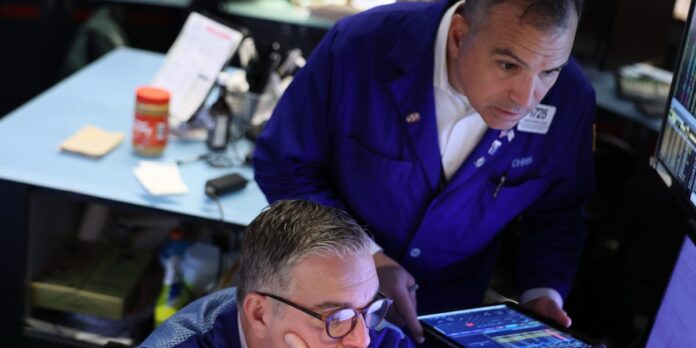Wall Street’s risk machine didn’t break this week — Friday’s rebound spared it. But it flinched. And in doing so, it revealed how fragile the current market cycle has become.
The shift was subtle, then sudden. For weeks, the riskiest trades in finance — crypto, AI stocks, meme names, high-octane momentum bets — had been slipping. On Thursday, that slow-motion retreat snapped. The Nasdaq 100 sank nearly 5% from its intraday peak, its sharpest reversal since April. Nvidia Corp. at one point shed nearly $400 billion despite beating earnings expectations. Bitcoin hit a seven-month low. Momentum names dropped in near-perfect sync.
It was a vivid reminder of how easily pressure can cascade through crowded trades, and how markets powered by momentum and retail enthusiasm can buckle without warning.
There was no obvious trigger. No policy shift. No data surprise. No earnings miss. Just a sudden wave of selling, and an equally abrupt recovery. What rattled investors wasn’t just the scale of the moves, but their speed, and what that speed suggested: a momentum-driven market, prone to synchronized swings and fragile under strain.
“There are real cracks,” said Nathan Thooft, chief investment officer at Manulife Investment Management, which oversees $160 billion. “When you have valuations at these levels and many assets priced for near perfection, any cracks and headline risks cause outsized reactions.”
Thooft began paring back equity exposure two weeks ago, reducing exposure to equity risk in tactical portfolios from overweight to neutral as volatility picked up. He now sees a market that’s splintering, not with a single story, but with “plenty to cheer about for the optimists and plenty of worries for the pessimists.”
The numbers are hard to ignore. Bitcoin is down more than 20% in November, its worst month since the 2022 crypto crash. Nvidia is heading for its steepest monthly decline since March. A Goldman Sachs index of retail-favored stocks has fallen 17% from its October high. Volatility has surged. Demand for crash protection has returned.
But the most visible tremors, and perhaps the most amplified, are playing out in crypto. The selloff in Bitcoin has mirrored the fall in high-beta stocks, strengthening the case that crypto is now moving in lockstep with broader risk assets.
The short-term correlation between Bitcoin and the Nasdaq 100 hit a record earlier this month, according to data compiled by Bloomberg. Even the S&P 500 showed unusual synchronicity with digital assets.
“There is perhaps an investor base — the more speculative and more levered segment of retail investors — that is common to both crypto and equity markets,” wrote JPMorgan strategist Nikolaos Panigirtzoglou, noting that blockchain innovation underpins a growing bridge between the two spheres.
data-srcyload
Ed Yardeni tied part of Thursday’s equity drop to Bitcoin’s plunge, calling the connection too tight to dismiss. And billionaire investor Bill Ackman offered his own comparison — claiming that his stake in Fannie Mae and Freddie Mac effectively acts as a kind of crypto proxy.
That dynamic — in which digital tokens rise and fall alongside speculative equities — tends to fade in quiet markets, only to return in moments of stress. “Like the Rockettes, they all dance in lockstep,” said Sam Stovall, chief investment strategist at CFRA. “Bitcoin is a representative of the risk-on, risk-off sentiment on steroids.”
While some claim crypto is leading the downturn, the case is thin. Institutional exposure is limited, and the asset’s price action tends to be more sentiment-prone than fundamental. Rather than setting the tone, crypto may simply register market stress in its most visible — and visceral — form: a highly leveraged, retail-heavy barometer where speculative nerves show first.
Other explanations for febrile stock trading are technical: volatility-linked funds shifting exposure, algorithmic flows tipping thresholds, options positioning unwinding. But all point to the same conclusion: in a crowded market, even small tremors can cascade.
Thursday’s sharp reversal only magnified that anxiety. The so-called fear gauge, the VIX, spiked to its highest level since April’s “Liberation Day” selloff. Traders rushed to buy crash protection. Adrian Helfert, chief investment officer at Westwood, was among those who had already begun repositioning in recent weeks, adding tail-risk hedges in anticipation of a regime shift. The crypto slump reinforces the broader retreat from risk assets, he said.
“Investors are viewing it less as a safe haven and more as a speculative holding to shed as market fear rises, leading to deleveraging and rapid ‘despeculation’ across high-risk segments,” Helfert said. “This is reinforcing the move away from risk assets.”
data-srcyload
Even Nvidia’s blowout earnings couldn’t hold the line. Despite topping expectations, the AI heavyweight fell sharply during the week, underscoring the broader pressure on tech valuations. The Nasdaq 100 notched its third straight weekly loss, shedding about 3%. Retail flows into single-name stocks also flipped negative for the week, according to JPMorgan estimates. And though the market bounced Friday — following dovish comments from New York Fed President John Williams — the rebound did little to erase the deeper sense of unease.
All of it points to a retreat from the frothiest parts of the market, where AI exuberance, speculative positioning, and cheap leverage have powered much of this year’s gains — and where conviction is now harder to find. And until recently, crash protection was difficult to justify. Risk assets had rallied hard since May, and those betting against the boom had repeatedly been burned. But now, even long-time bulls are looking over their shoulders.
“A lot of folks who have done well are right now discussing 2026 risk budgets, and obviously AI concerns are top of mind,” said Amy Wu Silverman, head of derivatives strategy at RBC Capital Markets. “A number of investors I have spoken with have wanted to hedge for a while. We jokingly call them the ‘fully invested bears.’”


